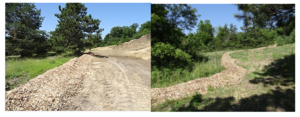
Construction stormwater best management practice – buffer zones
Contents
Buffer zones
An undisturbed buffer zone of not less than 100 linear feet from a special water is required in the construction stormwater general permit. Special waters are defined in Appendix A of the permit. Determining if your site is near special water can be quickly determined using the online mapping tool. Examples include the Mississippi River, Lake Superior, scenic or recreational river segments, wilderness areas, trout streams, and calcareous fens.
Riparian buffers
Riparian buffers are vegetated zones adjacent to streams and wetlands that represent a best management practice (BMP) for controlling many pollutants found in typical stormwater runoff. Many studies have shown that by maintaining a buffer around surface waters pollutant impacts from sediment, phosphorus, nitrogen and thermal impacts can be greatly reduced. In addition to the benefits of buffers as a long term stormwater BMP, maintaining a buffer during construction reduces the risk of a sediment discharge when it rains.
Permit requirements
When working near special waters, the general permit requires that an undisturbed buffer zone of at least 100 feet be maintained at all times. However the permit is clear regarding certain exceptions to this requirement such as water crossings or limited water access. There may be other situations where construction within the buffer is unavoidable. Some other examples include work being done to restore the buffer or remove refuse from within the buffer zone. Existing impervious surfaces (structures or pavement, e.g.) can be replaced by new impervious surfaces of the same size or smaller. The new impervious surface may be located in a different area within the buffer but should not be moved closer to the water body.
If the project involves the relocation of impervious surfaces, any environmental or scenic impacts over the existing conditions must be mitigated. If the impervious surface cannot be sited on a parcel without encroaching upon the buffer, the project may still be allowed coverage under this general permit if all water quality and scenic impacts are mitigated and documented in the SWPPP. An entire structure or a majority of a structure must not be located within the buffer zone unless it is a replacement. Scenic impacts must consider the aesthetic change caused by the project from all views from outside the project area.
Contact the Minnesota Pollution Control Agency (MPCA) during the design phase of the project to determine what additional BMPs may be necessary. If, after discussing the proposed project with the MPCA, and a determination is made that the project will qualify for the listed exception, restoration of the buffer zone must blend into and match the adjacent landscape visually. BMPs must also be selected to blend into the surrounding area as much as possible. Restoration of the buffer must be with the same/similar vegetation that existed prior to disturbance or would exist in a natural condition if not previously altered by human activities.
Trout streams
Trout are a unique species of fish that rely on cold water habitats for survival. Exposure to sunlight can cause adverse warming of the water. The shade provided by trees is very important to minimizing thermal impacts to trout streams. The removal of woody vegetation and replacement with grassy vegetation is not allowed by this permit unless the reasons are absolutely necessary and completely documented in the SWPPP.
